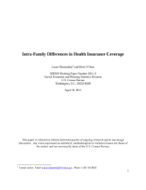Intra-Family Differences in Health Insurance Coverage
Intra-Family Differences in Health Insurance Coverage
Abstract
Public programs are an increasingly important way for children to obtain health insurance coverage. In 2009, over one third (35.2 percent) of insured children age 18 and under were covered by Medicaid, the Children’s Health Insurance Program (CHIP), or other means-tested public coverage programs (Mach and Blumenthal, 2010). However, program eligibility criteria and procedures for parents and children can differ, leading to intra-family differences in health insurance coverage (discordant coverage). Literature suggests that intra-family discordant coverage may hinder children’s access to care or reduce the utility of their coverage (Ku and Broaddus, 2000; Davidoff et. al, 2003; Minkovitz et. al, 2002). In addition, the propensity of families to substitute CHIP for private health insurance (crowd-out) is a growing concern for policymakers since the Children’s Health Insurance Program Reauthorization Act of 2009 (CHIPRA) (Blewett and Call, 2007; Gruber and Simon, 2008; U.S. GAO, 2009).
This national and state-level analysis uses the 2009 American Community Survey (ACS) to estimate within-family differences in health insurance coverage by discordant coverage status and type. From these estimates, we create a crude measure of child crowd-out at the state level. Our national-level analysis focuses on the socioeconomic characteristics of children covered by Medicaid or CHIP whose parents are uninsured or privately covered. Generally, states with more family-inclusive Medicaid/CHIP policies have more cohesive intra-family public coverage. Few states meet our child crowd-out hypothesis, and we find little evidence that states with more family-inclusive policy are more likely to have crowd-out. The results suggest that child crowd-out may not be as relevant as family crowd-out: states make decisions that may induce the whole family to substitute public coverage in place of employer-based insurance.
Others in Series
Working Paper
Working Paper
Working Paper




